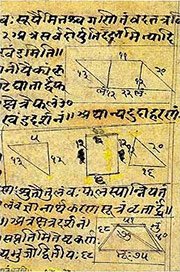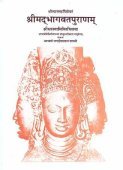Vishnupada, Viṣṇupada, Viṣṇupāda, Vishnu-pada: 15 definitions
Introduction:
Vishnupada means something in Hinduism, Sanskrit, the history of ancient India, Marathi. If you want to know the exact meaning, history, etymology or English translation of this term then check out the descriptions on this page. Add your comment or reference to a book if you want to contribute to this summary article.
The Sanskrit terms Viṣṇupada and Viṣṇupāda can be transliterated into English as Visnupada or Vishnupada, using the IAST transliteration scheme (?).
In Hinduism
Purana and Itihasa (epic history)
Source: archive.org: Puranic EncyclopediaViṣṇupada (विष्णुपद).—A place at the source of the river Gaṅgā See under Gaṅgā.
Source: Cologne Digital Sanskrit Dictionaries: The Purana Index1a) Viṣṇupada (विष्णुपद).—A lake in the Niṣadha hill;1 sacred to Pitṛs;2 the place where Dhruva is located.3
- 1) Brahmāṇḍa-purāṇa II. 18. 67; III. 43. 14; Matsya-purāṇa 121. 66; Vāyu-purāṇa 47. 64.
- 2) Matsya-purāṇa 22. 25.
- 3) Vāyu-purāṇa 50. 222.
1b) The path where Dharma, Dhruva and others take their stand above the seven sages; the region between the seven ṛṣis and Dhruva where live ascetics and yogis of a high order; the source of rain and the stay of the three worlds; from this proceeds the Gangā; issuing from the nail of the great toe of Viṣnu's left foot;1 the third division of the celestial region.2
1c) A mountain in Gayā; a hill where Dharmaratha performed a sacrifice.*
- * Matsya-purāṇa 48. 93; Vāyu-purāṇa 99. 102; 105. 26; 109. 18; 111. 46-7 and 56.
2) Viṣṇupāda (विष्णुपाद).—The celestial regions where Dhruva holds the Bhagavatpadī on his head with intense devotion;1 sacred for Gangā.2

The Purana (पुराण, purāṇas) refers to Sanskrit literature preserving ancient India’s vast cultural history, including historical legends, religious ceremonies, various arts and sciences. The eighteen mahapuranas total over 400,000 shlokas (metrical couplets) and date to at least several centuries BCE.
Ganitashastra (Mathematics and Algebra)
Source: archive.org: Hindu MathematicsViṣṇupada (विष्णुपद) represents the number 0 (zero) in the “word-numeral system” (bhūtasaṃkhyā), which was used in Sanskrit texts dealing with astronomy, mathematics, metrics, as well as in the dates of inscriptions and manuscripts in ancient Indian literature.—A system of expressing numbers by means of words arranged as in the place-value notation was developed and perfected in India in the early centuries of the Christian era. In this system the numerals [e.g., 0—viṣṇupada] are expressed by names of things, beings or concepts, which, naturally or in accordance with the teaching of the Śāstras, connote numbers.

Ganitashastra (शिल्पशास्त्र, gaṇitaśāstra) refers to the ancient Indian science of mathematics, algebra, number theory, arithmetic, etc. Closely allied with astronomy, both were commonly taught and studied in universities, even since the 1st millennium BCE. Ganita-shastra also includes ritualistic math-books such as the Shulba-sutras.
Yoga (school of philosophy)
Source: ORA: Amanaska (king of all yogas): A Critical Edition and Annotated Translation by Jason BirchViṣṇupada (विष्णुपद) refers to the “(supreme) state of Viṣṇu”, according to the Haṭhapradīpikā 4.100 (Cf. Uttaragīta 41cd-42, Maṇḍalabrāhmaṇopaniṣat 2.5.4-5, Gheraṇḍasaṃhitā 5.82-83ab).—Accordingly, “The mind becomes absorbed in the resonance of the unstruck sound which is perceived [first], [then] the light in the resonance and [then] the mind in the light. It is the supreme state of Viṣṇu (viṣṇupada) [viṣṇoḥ paramaṃ padam].”.

Yoga is originally considered a branch of Hindu philosophy (astika), but both ancient and modern Yoga combine the physical, mental and spiritual. Yoga teaches various physical techniques also known as āsanas (postures), used for various purposes (eg., meditation, contemplation, relaxation).
India history and geography
Source: archive.org: Personal and geographical names in the Gupta inscriptionsViṣṇupada (विष्णुपद) is the name of a mountain mentioned in the Gupta inscription No. 20. The Gupta empire (r. 3rd-century CE), founded by Śrī Gupta, covered much of ancient India and embraced the Dharmic religions such as Hinduism, Buddhism and Jainism. We know from the inscription that a lofty standard of the divine Viṣṇu was set up on the hill called Viṣṇupada.
Viṣṇupada literally means “the hill marked with footprints of Viṣṇu”. Viṣṇupada hill has been identified with that part of the Delhi Ridge on which the column stands. But there is no mountain in Delhi and the inscription appears to have been brought there from the mount Viṣṇupada. On the evidence from the Epics, this Viṣṇupada hill is not far from Kurukshetra and the Beas.
Source: Cologne Digital Sanskrit Dictionaries: Indian Epigraphical GlossaryViṣṇu-pada.—(IE 7-1-2), ‘cypher’. Note: viṣṇu-pada is defined in the “Indian epigraphical glossary” as it can be found on ancient inscriptions commonly written in Sanskrit, Prakrit or Dravidian languages.

The history of India traces the identification of countries, villages, towns and other regions of India, as well as mythology, zoology, royal dynasties, rulers, tribes, local festivities and traditions and regional languages. Ancient India enjoyed religious freedom and encourages the path of Dharma, a concept common to Buddhism, Hinduism, and Jainism.
Languages of India and abroad
Marathi-English dictionary
Source: DDSA: The Molesworth Marathi and English Dictionaryviṣṇupada (विष्णुपद).—n (S) An image of the foot of viṣṇu, worshiped at the holy place Gaya.
Marathi is an Indo-European language having over 70 million native speakers people in (predominantly) Maharashtra India. Marathi, like many other Indo-Aryan languages, evolved from early forms of Prakrit, which itself is a subset of Sanskrit, one of the most ancient languages of the world.
Sanskrit dictionary
Source: DDSA: The practical Sanskrit-English dictionaryViṣṇupada (विष्णुपद).—
1) the sky, atmosphere.
2) the sea of milk.
3) the foot of Viṣṇu (worshipped at Gayā).
4) a lotus.
Derivable forms: viṣṇupadam (विष्णुपदम्).
Viṣṇupada is a Sanskrit compound consisting of the terms viṣṇu and pada (पद).
Source: Cologne Digital Sanskrit Dictionaries: Shabda-Sagara Sanskrit-English DictionaryViṣṇupada (विष्णुपद).—n.
(-daṃ) 1. The sky, heaven, atmosphere. 2. The sea of milk. 3. A lotus. f. (-dī) 1. The Ganges. 2. One of the twelve Sankrantis or periods, at which the sun enters a sign of the zodiac, especially the first sign after the equinox. E. viṣṇu, and pada abode, or foot; where Vishnu resides or rests, or proceeding from his foot.
Source: Cologne Digital Sanskrit Dictionaries: Benfey Sanskrit-English DictionaryViṣṇupada (विष्णुपद).—I. n. 1. the sky. 2. the sea of milk. 3. a lotus. Ii. f. dī, the Ganges.
— Cf. [Latin] oppidum.
Viṣṇupada is a Sanskrit compound consisting of the terms viṣṇu and pada (पद).
Source: Cologne Digital Sanskrit Dictionaries: Cappeller Sanskrit-English DictionaryViṣṇupada (विष्णुपद).—[neuter] Viṣṇu’s domain (the sky).
Source: Cologne Digital Sanskrit Dictionaries: Monier-Williams Sanskrit-English Dictionary1) Viṣṇupada (विष्णुपद):—[=viṣṇu-pada] [from viṣṇu] n. ‘station or footmark of V°’, the zenith, [Nirukta, by Yāska; Bhāgavata-purāṇa]
2) [v.s. ...] the sky, [Mahābhārata; Raghuvaṃśa] etc.
3) [v.s. ...] the mark of V°’s foot worshipped at Gayā, [Religious Thought and Life in India 309]
4) [v.s. ...] Name of a sacred hill (also called da-giri, m.), [Mahābhārata; Harivaṃśa] etc.
5) [v.s. ...] a lotus, [cf. Lexicographers, esp. such as amarasiṃha, halāyudha, hemacandra, etc.]
6) [v.s. ...] m. n. the sea of milk, [cf. Lexicographers, esp. such as amarasiṃha, halāyudha, hemacandra, etc.]
Source: Cologne Digital Sanskrit Dictionaries: Yates Sanskrit-English DictionaryViṣṇupada (विष्णुपद):—[viṣṇu-pada] (daṃ) 1. n. The sky; sea of milk; lotus. f. Ganges; period of the sun’s entering a zodiacal sign.
[Sanskrit to German]
Sanskrit, also spelled संस्कृतम् (saṃskṛtam), is an ancient language of India commonly seen as the grandmother of the Indo-European language family (even English!). Closely allied with Prakrit and Pali, Sanskrit is more exhaustive in both grammar and terms and has the most extensive collection of literature in the world, greatly surpassing its sister-languages Greek and Latin.
Kannada-English dictionary
Source: Alar: Kannada-English corpusViṣṇupada (ವಿಷ್ಣುಪದ):—
1) [noun] the sky.
2) [noun] the state of being liberated from the worldly births and deaths; final emancipation.
--- OR ---
Viṣṇupāda (ವಿಷ್ಣುಪಾದ):—[noun] a holy place in Gaya, in Bihar.
Kannada is a Dravidian language (as opposed to the Indo-European language family) mainly spoken in the southwestern region of India.
See also (Relevant definitions)
Partial matches: Vishnu, Pada, Pata.
Starts with: Vishnupadadikeshamtastuti, Vishnupadadikeshantastuti, Vishnupadagiri, Vishnupadashraddha, Vishnupadatirtha, Vishnupatam.
Full-text (+17): Vishnupadatirtha, Vishnupadagiri, Vishnupadashraddha, Dharmaratha, Natvali, Satatya, Vishnupadyutpatti, Vintupatam, Vishnupadicakra, Vaikunthiya, Vittunupatam, Mahita, Salilanidhi, Salilarashi, Yadiya, Gandharvi, Vishnupadi, Bhagavatpadi, Pariyatra, Subhadra.
Relevant text
Search found 32 books and stories containing Vishnupada, Viṣṇupada, Viṣṇupāda, Visnupada, Vishnu-pada, Viṣṇu-pada, Visnu-pada, Viṣṇu-pāda; (plurals include: Vishnupadas, Viṣṇupadas, Viṣṇupādas, Visnupadas, padas, pādas). You can also click to the full overview containing English textual excerpts. Below are direct links for the most relevant articles:
Srila Gurudeva (The Supreme Treasure) (by Swami Bhaktivedanta Madhava Maharaja)
Serving the Society–Serving the Devotees < [Chapter 1.2 - Śrīla Gurudeva’s Pūrvāśrama]
Shrimad Bhagavad-gita (by Narayana Gosvami)
Preface (to the Fourth English Edition)
Introduction (conclusion) < [Introduction (to the Hindi edition)]
Bhajana-Rahasya (by Srila Bhaktivinoda Thakura Mahasaya)
Brihad Bhagavatamrita (commentary) (by Śrī Śrīmad Bhaktivedānta Nārāyana Gosvāmī Mahārāja)
Verse 2.1.1 < [Chapter 1 - Vairāgya (renunciation)]
Katha Upanishad with Shankara’s Commentary (by S. Sitarama Sastri)
Verse 1.3.4 < [Adyaya I, Valli III - The parable of the chariot]
Rasa Jala Nidhi, vol 5: Treatment of various afflictions (by Bhudeb Mookerjee)
Part 6 - Chemists of the Metallic School: Chandra Sena < [A Brief History of Indian Chemistry and Medicine]
Related products
